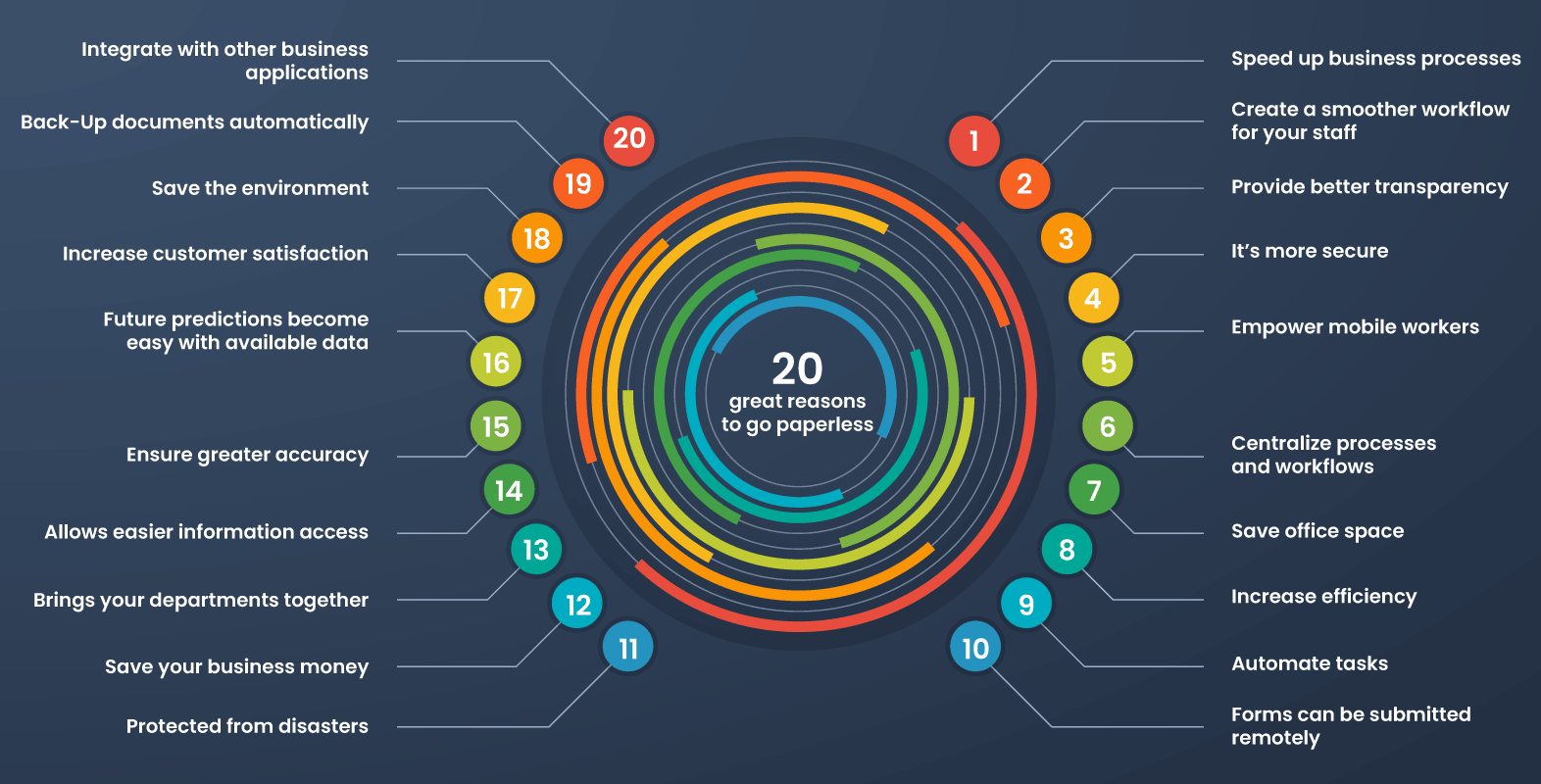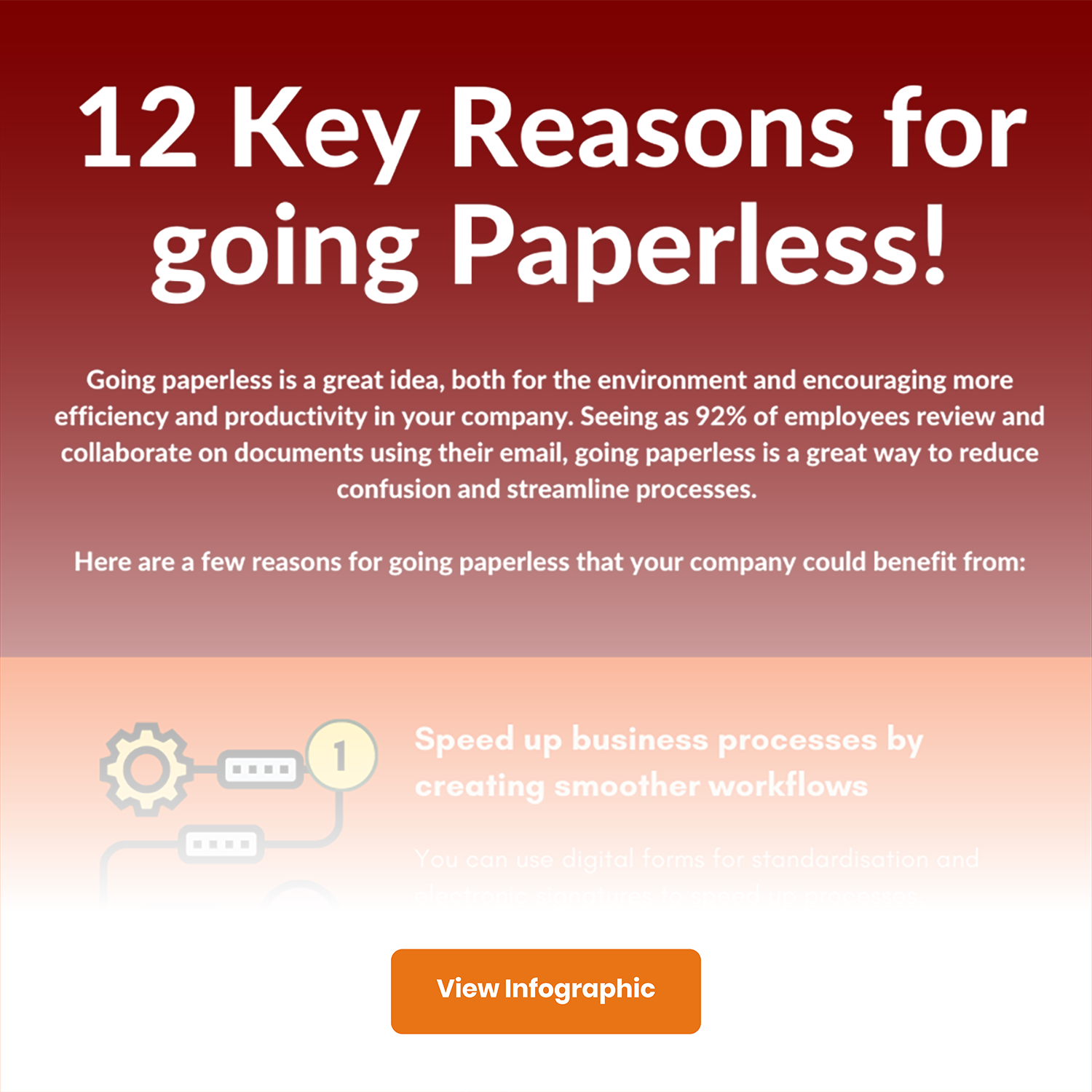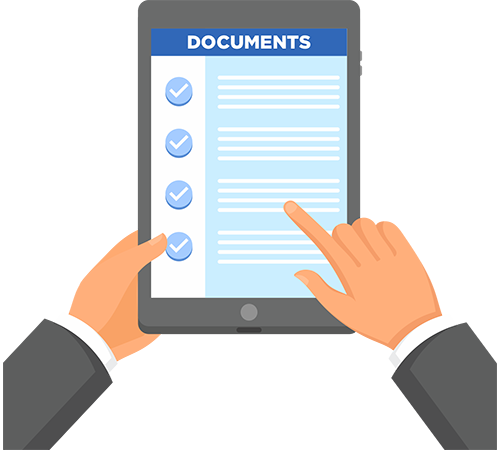
As the digital world grows and technology becomes more available to companies of all sizes, it is becoming easier to operate a paperless business.
A key phrase of the digital era has taken over businesses everywhere. The phrase is “going paperless,” which refers to the process of shifting all documentation, files, and records to a digital format.
If you’re still dependent on paper documents in your company, here are 20 reasons to consider going paperless.
20 great reasons to go paperless

1. Speed up business processes
Committing to going paperless makes it easier for the company to move faster.
Using digital forms to standardize processes and switch to electronic signatures saves time on printing documents, setting up in-person meetings, and maintaining hard copies.
By taking online payments and issuing digital checks, you can securely monitor cash flow and don’t have to think about going to the bank to make deposits.
2. Create a smoother workflow for your staff
How much of your staff’s time is spent searching for the documents in emails and elsewhere?
Employees spend time on printing documents, ensuring that they are filled out by customers, scanning submitted papers, adding those files to digital databases, and then filing those papers.
Digital processes & going paperless also enable automation for routine tasks and make team collaboration much easier.
3. Provide better transparency

Most paper forms are part of some of the other business processes. Automating the forms along with the associated process provided transparency in the overall operations. With automation, you get clear logs for every task that show what was done, who did it, and when it was done.
4. It’s more secure
When physically moving between offices, departments, and personnel, paper forms are subject to data theft, unlike when saved in a computer system protected with adequate security controls.
By going paperless, critical information is held safely in the cloud and continuously backed up, which ensures that you will still have access to critical information even in the case of a disaster.
Also read: RIP paper-based forms – It’s time to go paperless with forms automation
5. Empower mobile workers
When an official visits a property, he or she will access and update the property file in real time via a mobile device.
It reduces the time needed to enter the data later because since the document is stored in the cloud, it ensures that all departments have direct access to up-to-date information as long as the official updates it.
Watch Webinar: The message from the industry is unequivocal: Digitize or Perish
6. Centralize processes and workflows
Whenever a paper form needs to be changed, it’s a waste of a lot of paper. Bringing documents into the hands of various stakeholders for analysis requires a lot of time.
Digital forms can be made available to all stakeholders through a real-time centralized database, reducing unnecessary meetings and emails.
7. Save office space
How much space is your company currently using to store physical paper documents?
Not only are you paying for renting the space, but it involves a physical search to find the necessary documents. A cloud-based storage system needs little to no physical space.
Also Read: Top 10 Business Process Automation Benefits
8. Increase efficiency
Paper processes are elaborate and slow, and often it’s hard to find what you’re searching for in a never-ending paper trail.
The electronic filing system is infinitely faster than the manual file system. With Digital document management and knowledge management systems, everything you need can be found by clicking a button, increasing productivity and efficiency by as much as 70%.

9. Automate tasks
Digital forms, which are filled out by the public and employees, automatically fill databases with details, eliminating the need for manual data entry.
10. Forms can be submitted remotely

Clients, Customers, and Employees can access, complete, and send forms remotely on any device.
11. Integrate with other business applications
One of the biggest conveniences of digital data is that it can be integrated quickly and conveniently with other business applications.
For example, you can talk about the terms of the deal, draw up a contract, make changes requested by your client, and send the contract to him at once in a single sitting with the available digitally transformed data.
12. Back-Up documents automatically
A comprehensive data protection system includes the periodic, automatic backup of all your stored data. If your company is exposed to a malicious virus or system failure, you can turn to backup to restore order seamlessly.
13. Save the environment
Approximately half of the business waste consists of paper, and the U.S. offices use 12.1 trillion sheets of paper annually, according to The World Counts, an organization that tracks statistics about the state of our planet.
The eco-friendly benefits of going paperless may not be as clear as cost-and space-related savings, but they are certainly worth it.
14. Increase customer satisfaction
Customer loyalty is essential for a company to survive in the digital era. Bad reviews and dissatisfied customers could result in unrecoverable losses.
Digital forms allow you to provide your customers with more accurate and reliable information. A happy customer is the most valuable asset that a company can have.
15. Future predictions become easy with available data
With paper forms, the analysis of data available is time-consuming and could be inaccurate. This lack of automation could add up to your costs. Data collected can also be used to forecast outcomes and help you set up processes to improve or further develop your business through paperless business automation.
Also read: 15 Ways to Transform your Business with Mobile Forms
16. Ensure greater accuracy
This advantage is twofold. On the customer side, if they can fill out forms at their leisure when it is most convenient, there is a better probability that they can enter details more accurately and precisely. On the employee’s side, digital files and workflow make it error-free.
17. Allows easier information access
Because the documentation is completely digital, all approved personnel can access reports and data anytime from any place. This makes it easier for team members to work together and faster to create, edit, and update files as needed.
18. Brings your departments together
With centralized information, all the departments can work together on the same information. It would make it easier for employees in all departments to access, manage, and make decisions based on current and accurate data. Costly human error is reduced, communication gaps are eliminated, and teams can work together efficiently.
19. Save your business money
Going paperless allows your business to minimize costs for equipment such as printers and scanners as well as office supplies such as paper, ink, toner, paper clips, buttons, folders, and more. Becoming a paperless office can mean a lot of savings for your business.
20. Protected from disasters
Pandemics, Fire accidents, dust storms, floods, air conditioner leaks, and mice. The list of problems that can affect paper documents is endless.
Going paperless positively affects the company’s disaster plan because virtual documents are stored off-site in a secure environment and protected from fire, robbery, and other disasters that can impact the office.

Tips for Going Paperless
With the new technologies and online applications, reducing the use of paper is possible.
Check out these easy tips for creating a paperless office:
- Automate all paper-based processes in your company.
- Provide an interface for external users to submit data digitally instead of sending it by post or emails
- Request paperless statements from banks
- Reduce, and discourage paper usage in the office
- Reward employees who help you go paperless
Conclusion
Digital transformation offers cost and time savings to businesses of every size and type. Undoubtedly, the environment is a factor to consider in going paperless.
The digital transformation of the company processes is not only immensely rewarding, but it is also becoming necessary due to technological advancements and demands in the 21st century.
Begin your journey towards streamlined operations and tailored apps – all with the simplicity of our platform. Get started today to harness the potential of automation.
Frequently Asked Questions(FAQs)
What does it mean to go paperless?
Going paperless means reducing or eliminating the use of physical paper documents.
What are the ways to go paperless?
Ways to go paperless office: use digital files, cloud storage, electronic signatures, and digital communication.
Why should we go paperless?
Reasons to go paperless: reduce environmental impact, save time, and improve organization.
Is it best to go paperless?
Whether it’s best to go paperless depends on your specific needs and circumstances.
What happens when you go paperless?
Going paperless can result in less clutter, easier document access, and reduced paper waste.
Login
Please login to comment
0 Comments
Oldest















